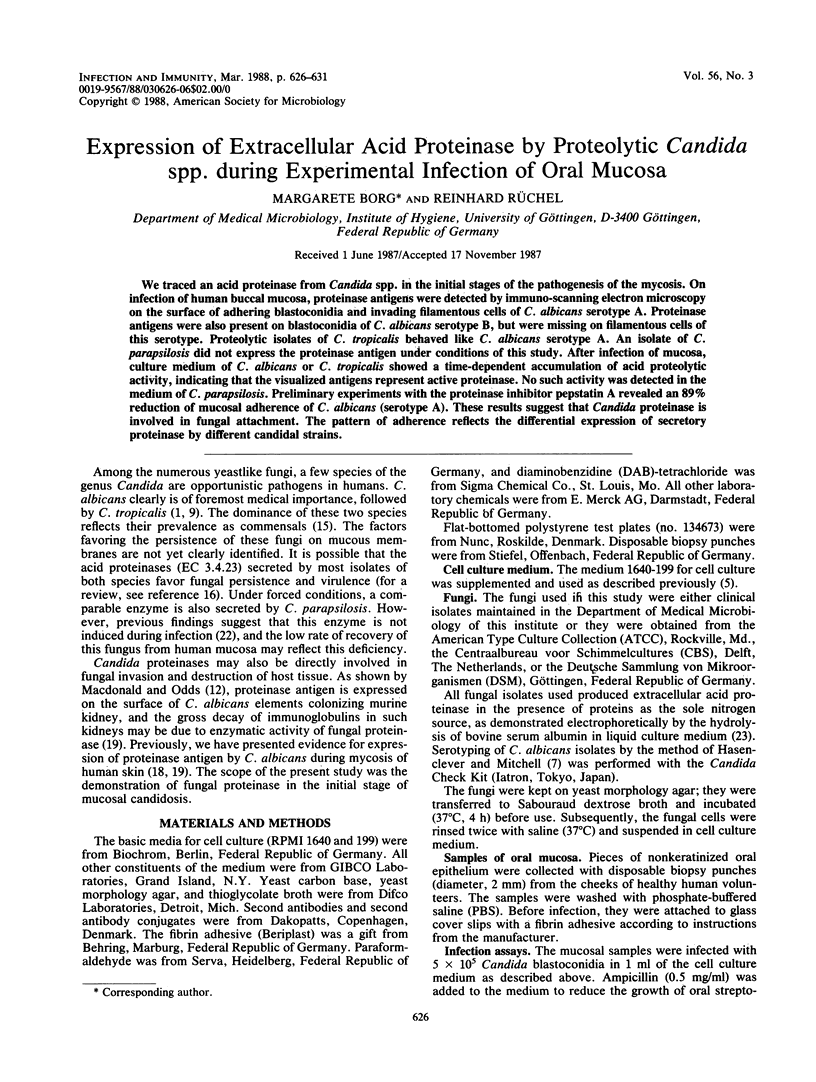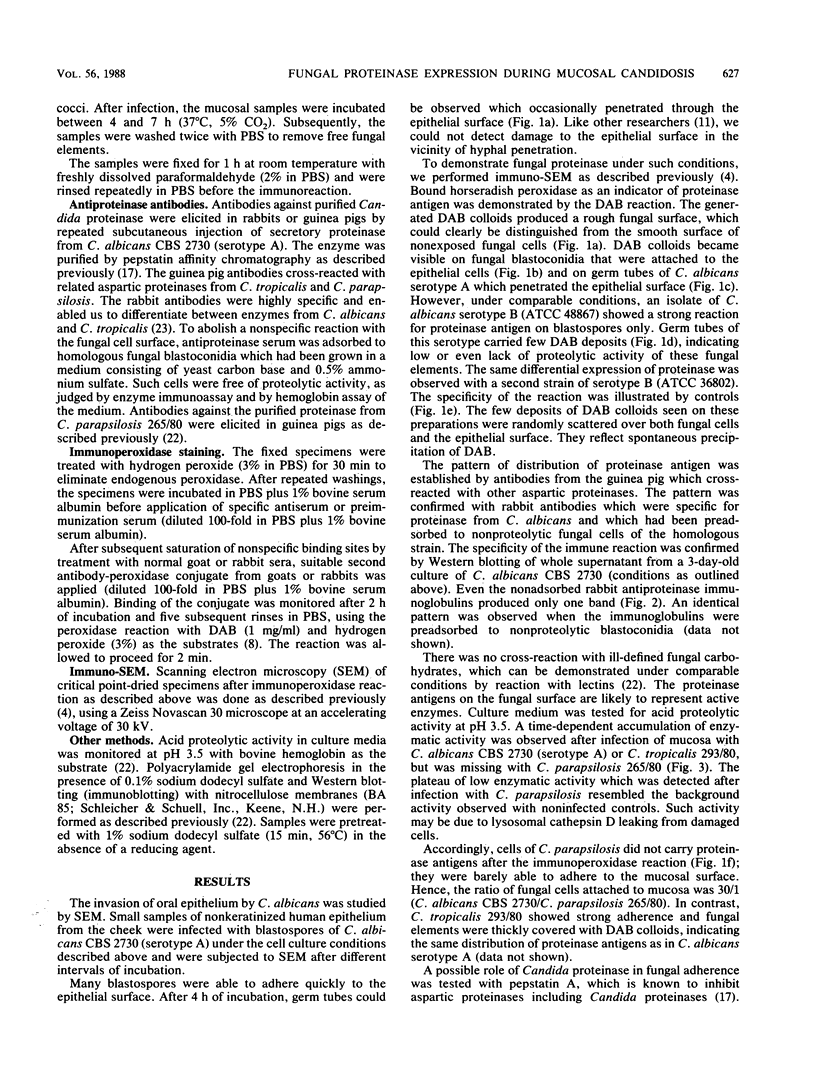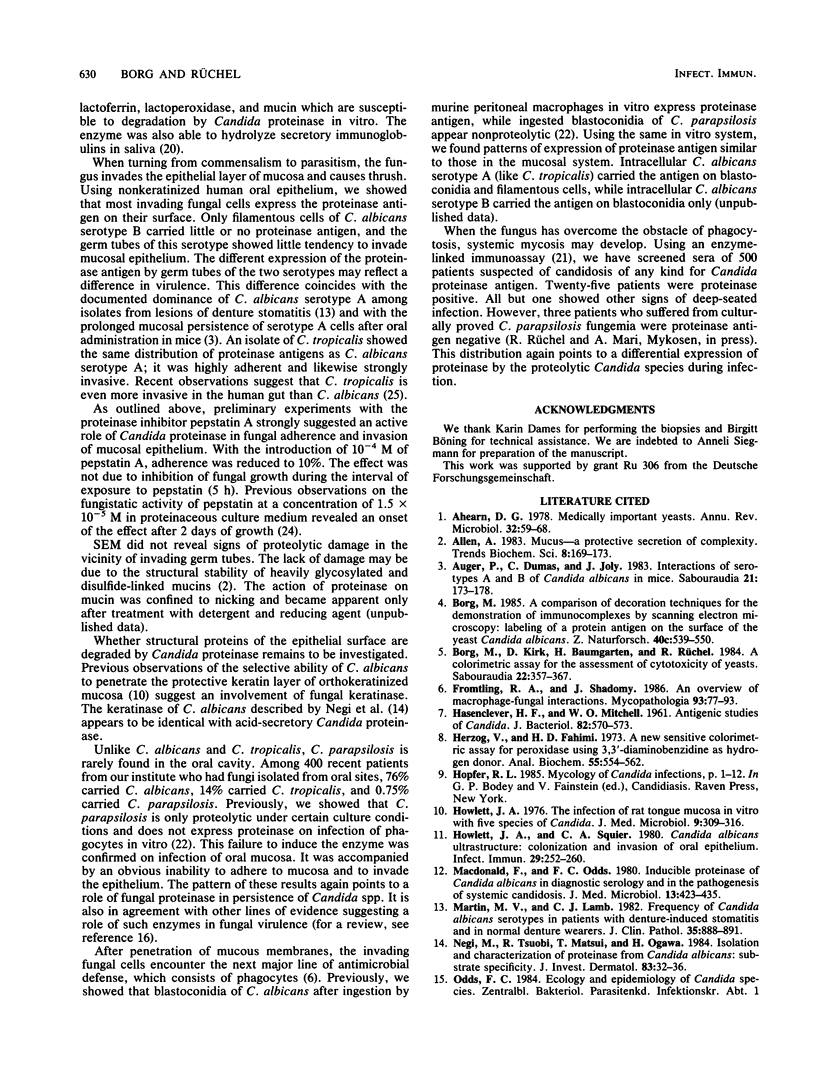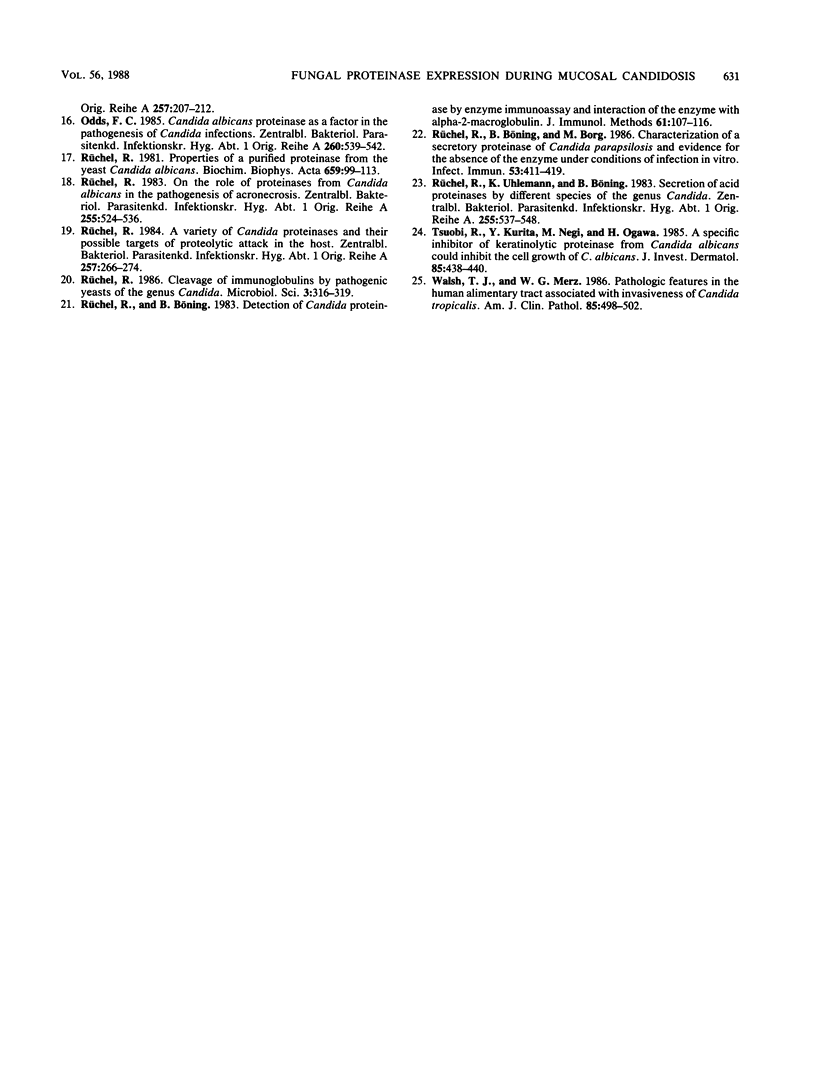Abstract
We traced an acid proteinase from Candida spp. in the initial stages of the pathogenesis of the mycosis. On infection of human buccal mucosa, proteinase antigens were detected by immuno-scanning electron microscopy on the surface of adhering blastoconidia and invading filamentous cells of C. albicans serotype A. Proteinase antigens were also present on blastoconidia of C. albicans serotype B, but were missing on filamentous cells of this serotype. Proteolytic isolates of C. tropicalis behaved like C. albicans serotype A. An isolate of C. parapsilosis did not express the proteinase antigen under conditions of this study. After infection of mucosa, culture medium of C. albicans or C. tropicalis showed a time-dependent accumulation of acid proteolytic activity, indicating that the visualized antigens represent active proteinase. No such activity was detected in the medium of C. parapsilosis. Preliminary experiments with the proteinase inhibitor pepstatin A revealed an 89% reduction of mucosal adherence of C. albicans (serotype A). These results suggest that Candida proteinase is involved in fungal attachment. The pattern of adherence reflects the differential expression of secretory proteinase by different candidal strains.
Full text
PDF





Images in this article
Selected References
These references are in PubMed. This may not be the complete list of references from this article.
- Ahearn D. G. Medically important yeasts. Annu Rev Microbiol. 1978;32:59–68. doi: 10.1146/annurev.mi.32.100178.000423. [DOI] [PubMed] [Google Scholar]
- Auger P., Dumas C., Joly J. Interactions of serotypes A and B of Candida albicans in mice. Sabouraudia. 1983 Sep;21(3):173–178. [PubMed] [Google Scholar]
- Borg M., Kirk D., Baumgarten H., Rüchel R. A colorimetric assay for the assessment of cytotoxicity of yeasts. Sabouraudia. 1984;22(5):357–367. doi: 10.1080/00362178485380611. [DOI] [PubMed] [Google Scholar]
- Borg M. Vergleich verschiedener Immun-Dekorationsmethoden für die Rasterelektronenmikroskopie am Beispiel eines Protein-Antigens auf der Oberfläche der Hefe Candida albicans. Z Naturforsch C. 1985 Jul-Aug;40(7-8):539–550. [PubMed] [Google Scholar]
- Fromtling R. A., Shadomy H. J. An overview of macrophage-fungal interactions. Mycopathologia. 1986 Feb;93(2):77–93. doi: 10.1007/BF00437738. [DOI] [PubMed] [Google Scholar]
- HASENCLEVER H. F., MITCHELL W. O. Antigenic studies of Candida. I. Observation of two antigenic groups in Candida albicans. J Bacteriol. 1961 Oct;82:570–573. doi: 10.1128/jb.82.4.570-573.1961. [DOI] [PMC free article] [PubMed] [Google Scholar]
- Herzog V., Fahimi H. D. A new sensitive colorimetric assay for peroxidase using 3,3'-diaminobenzidine as hydrogen donor. Anal Biochem. 1973 Oct;55(2):554–562. doi: 10.1016/0003-2697(73)90144-9. [DOI] [PubMed] [Google Scholar]
- Howlett J. A., Squier C. A. Candida albicans ultrastructure: colonization and invasion of oral epithelium. Infect Immun. 1980 Jul;29(1):252–260. doi: 10.1128/iai.29.1.252-260.1980. [DOI] [PMC free article] [PubMed] [Google Scholar]
- Howlett J. A. The infection of rat tongue mucosa in vitro with five species of Candida. J Med Microbiol. 1976 Aug;9(3):309–316. doi: 10.1099/00222615-9-3-309. [DOI] [PubMed] [Google Scholar]
- Macdonald F., Odds F. C. Inducible proteinase of Candida albicans in diagnostic serology and in the pathogenesis of systemic candidosis. J Med Microbiol. 1980 Aug;13(3):423–435. doi: 10.1099/00222615-13-3-423. [DOI] [PubMed] [Google Scholar]
- Martin M. V., Lamb D. J. Frequency of Candida albicans serotypes in patients with denture-induced stomatitis and in normal denture wearers. J Clin Pathol. 1982 Aug;35(8):888–891. doi: 10.1136/jcp.35.8.888. [DOI] [PMC free article] [PubMed] [Google Scholar]
- Negi M., Tsuboi R., Matsui T., Ogawa H. Isolation and characterization of proteinase from Candida albicans: substrate specificity. J Invest Dermatol. 1984 Jul;83(1):32–36. doi: 10.1111/1523-1747.ep12261656. [DOI] [PubMed] [Google Scholar]
- Odds F. C. Candida albicans proteinase as a virulence factor in the pathogenesis of Candida infections. Zentralbl Bakteriol Mikrobiol Hyg A. 1985 Dec;260(4):539–542. doi: 10.1016/s0176-6724(85)80069-9. [DOI] [PubMed] [Google Scholar]
- Odds F. C. Ecology and epidemiology of Candida species. Zentralbl Bakteriol Mikrobiol Hyg A. 1984 Jul;257(2):207–212. [PubMed] [Google Scholar]
- Rüchel R. A variety of Candida proteinases and their possible targets of proteolytic attack in the host. Zentralbl Bakteriol Mikrobiol Hyg A. 1984 Jul;257(2):266–274. [PubMed] [Google Scholar]
- Rüchel R., Böning B., Borg M. Characterization of a secretory proteinase of Candida parapsilosis and evidence for the absence of the enzyme during infection in vitro. Infect Immun. 1986 Aug;53(2):411–419. doi: 10.1128/iai.53.2.411-419.1986. [DOI] [PMC free article] [PubMed] [Google Scholar]
- Rüchel R., Böning B. Detection of Candida proteinase by enzyme immunoassay and interaction of the enzyme with alpha-2-macroglobulin. J Immunol Methods. 1983 Jun 24;61(1):107–116. doi: 10.1016/0022-1759(83)90014-5. [DOI] [PubMed] [Google Scholar]
- Rüchel R. Cleavage of immunoglobulins by pathogenic yeasts of the genus Candida. Microbiol Sci. 1986 Oct;3(10):316–319. [PubMed] [Google Scholar]
- Rüchel R. On the role of proteinases from Candida albicans in the pathogenesis of acronecrosis. Zentralbl Bakteriol Mikrobiol Hyg A. 1983 Nov;255(4):524–536. [PubMed] [Google Scholar]
- Rüchel R. Properties of a purified proteinase from the yeast Candida albicans. Biochim Biophys Acta. 1981 May 14;659(1):99–113. doi: 10.1016/0005-2744(81)90274-6. [DOI] [PubMed] [Google Scholar]
- Rüchel R., Uhlemann K., Böning B. Secretion of acid proteinases by different species of the genus Candida. Zentralbl Bakteriol Mikrobiol Hyg A. 1983 Nov;255(4):537–548. [PubMed] [Google Scholar]
- Tsuobi R., Kurita Y., Negi M., Ogawa H. A specific inhibitor of keratinolytic proteinase from Candida albicans could inhibit the cell growth of C. albicans. J Invest Dermatol. 1985 Nov;85(5):438–440. doi: 10.1111/1523-1747.ep12277147. [DOI] [PubMed] [Google Scholar]
- Walsh T. J., Merz W. G. Pathologic features in the human alimentary tract associated with invasiveness of Candida tropicalis. Am J Clin Pathol. 1986 Apr;85(4):498–502. doi: 10.1093/ajcp/85.4.498. [DOI] [PubMed] [Google Scholar]




